Pluto - Study guides, Class notes & Summaries
Looking for the best study guides, study notes and summaries about Pluto? On this page you'll find 258 study documents about Pluto.
Page 4 out of 258 results
Sort by

-
Astro Ch 7 & 8 Homework Questions and answers 2024 verified to pass
- Exam (elaborations) • 4 pages • 2024
- Available in package deal
-
- $13.49
- + learn more
Astro Ch 7 & 8 Homework Questions and answers 2024 verified to passAstro Ch 7 & 8 Homework Questions Farthest to closest from the Sun: - correct answer Pluto, Saturn, Jupiter, Mars, Earth, Mercury Planets from highest --> lowest mass: - correct answer Sun, Jupiter, Earth, Mars, Mercury, Pluto Planets from largest --> smallest radius: - correct answer Sun, Jupiter, Earth, Mars, Mercury, Pluto Characteristics of terrestrial planets: - correct answer Solid, rocky surface; locat...
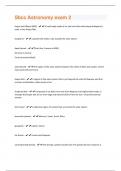
-
Sbcc Astronomy exam 2 Questions With 100% Correct Answers
- Exam (elaborations) • 10 pages • 2024
- Available in package deal
-
- $7.99
- + learn more
Kuiper belt Object (KBO) - A small body made of ice and rock that orbits beyond Neptune's orbit, in the Kuiper Belt. Exoplanet - a planet that orbits a star outside the solar system dwarf planet - Pluto (has 5 moons in KBO) Eris (has 5 moons) Ceres (in asteroid belt) asteroid belt - the region of the solar system between the orbits of Mars and Jupiter, where many asteroids are found Kuiper belt - A region of the solar system that is just beyond the orbit of Neptune and that contains sm...
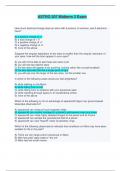
-
ASTRO 207 Midterm 2 Exam - Questions with 100% Correct Answers
- Exam (elaborations) • 10 pages • 2024
-
- $15.99
- + learn more
ASTRO 207 Midterm 2 Exam - Questions with 100% Correct Answers How much electrical charge does an atom with 6 protons, 6 neutrons, and 5 electrons have? A) a positive charge of +1 B) a total charge of +17 C) a positive charge of +7 D) a negative charge of -5 E) none of the above Suppose the angular separation of two stars is smaller than the angular resolution of your eyes. How will the stars appear to your eyes? A) you will not be able to see these two stars at all B) you will see two distinc...
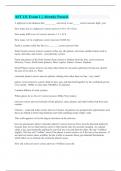
-
AST 111 Exam 1 || Already Passed.
- Exam (elaborations) • 15 pages • 2024
- Available in package deal
-
- $11.99
- + learn more
A lightyear is the distance that _________ can travel in one _____ correct answers light, year How many km in a lightyear? correct answers 9.50 x 10^12 km How many KM in an AU correct answers 1.5 x 10^8 How many AU in a lightyear correct answers 63,000 AU Earth is a planet while the Sun is a________ correct answers Star Solar System correct answers consists of the sun, the planets, and some smaller bodies such as moon, asteroids, and comets - one planetary system Name the plane...
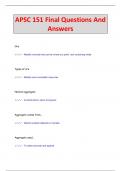
-
APSC 151 Final Questions And Answers
- Exam (elaborations) • 51 pages • 2024
- Available in package deal
-
- $12.99
- + learn more
Tsar bomb ~ Largest fusion bomb (3500x Hiroshima) Solar flare ~ Eruption of charged particles caused by Sun's magnetic field due to rotation of material and energy inside Sun Solar cycles ~ Every however many years there are solar highs were there is more stuff happening, e.g. you can see Northern Lights in Kingston Earth's magnetic field ~ Pulls Sun's particles up and pulls them into poles (Northern and Southern Lights), very slowly breaking down Mercury ~ Only planet with mag...
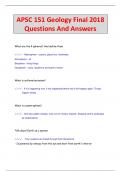
-
APSC 151 Geology Final 2018 Questions And Answers
- Exam (elaborations) • 130 pages • 2024
- Available in package deal
-
- $14.19
- + learn more
what isn't known about saturn ~ no one knows how long a day on saturn is what is necessary to be considered a planet ~ 1. a planet orbits the sun directly 2. a planet is large enough to have formed a spherical shape 3. a planet has cleared the neighbourhood around its orbit (this omits pluto as a planet) what is the orgin of water ~ - waster must have been delivered to earth by small bodies at a later stage of the planets evolution ~asteroid like small bodies from the region of jupi...
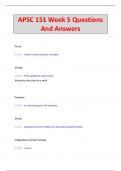
-
APSC 151 Week 5 Questions And Answers
- Exam (elaborations) • 18 pages • 2024
- Available in package deal
-
- $11.49
- + learn more
Jupiter ~ largest planet gas giant strong magnetic field counter rotating layers in the atmosphere mantle composed of metallic hydrogen Has 79 orbiting moons Saturn ~ second-largest and sixth planet from the Sun; has a complex ring system, at least 31 moons, and a thick atmosphere made mostly of hydrogen and helium No one knows how long one day on Saturn is Uranus ~ 7th planet from the sun planets ~ 1. A planet orbits the Sun directly (is not a satellite) 2. A planet is large en...
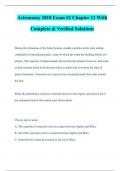
-
Astronomy 1010 Exam #2 Chapter 12 With Complete & Verified Solutions
- Exam (elaborations) • 12 pages • 2023
-
- $11.48
- + learn more
During the formation of the Solar System, smaller particles in the solar nebula combined to form planetesimals, some of which provided the building blocks for planets. The majority of planetesimals did not become planets, however, and some of them remain in the Solar System today as debris left over from the time of planet formation. Asteroids are a special class of planetesimals that orbit around the Sun. Study the distribution of known asteroids shown in this figure, and choose all of t...
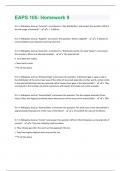
-
EAPS 105: Homework 9 Questions And Answers With Latest Quiz
- Exam (elaborations) • 3 pages • 2024
- Available in package deal
-
- $7.99
- + learn more
9.1. In Wikipedia, look up "Asteroid", scroll down to "Size distribution" and answer this question: What is the size range of asteroids? - c. 1-1,000 km 9.2. In Wikipedia, look up "Regolith" and answer this question: What is regolith? - c. A blanket of unconsolidated, loose deposits covering solid rock. 9.3. In Wikipedia, look up "Asteroid", scroll down to "Distribution within the Solar System", and answer this question: Where are asteroids located? - a. The asteroid belt b. Co-o...

-
Astronomy Final Exam Questions With Correct Answers
- Exam (elaborations) • 57 pages • 2024
-
- $11.49
- + learn more
Astronomy Final Exam Questions With Correct Answers A solar system contains a. primarily planets b. large amounts of gas and dust but very few stars c. large amounts of gas dust and stars d. a single star and planets e. thousands of super clusters - answerd. a single star and planets A galaxy contains a. primarily planets b. large amounts of gas and dust but very few stars c. large amounts of gas, dust, and stars d. a single star and planets e. thousands of super clusters - answerc....

Do you wonder why so many students wear nice clothes, have money to spare and enjoy tons of free time? Well, they sell on Stuvia! Imagine your study notes being downloaded a dozen times for $15 each. Every. Single. Day. Discover all about earning on Stuvia


